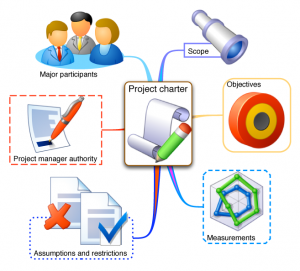 The first step of the Define phase of Six Sigma’s DMAIC methodology involves defining a project by creating a project charter. The project charter is a written document that captures and summarizes the elements of the project by explaining the business case, the scope of the project and its goals.
The first step of the Define phase of Six Sigma’s DMAIC methodology involves defining a project by creating a project charter. The project charter is a written document that captures and summarizes the elements of the project by explaining the business case, the scope of the project and its goals.
To subject matter experts and team members who are familiar with the process under review for improvement, this step may seem unnecessary and the course of action may appear obvious. Project team members, who view the project charter as no more than an inconvenient formality before the real work begins, and are tempted to skip over it, are making a serious mistake.
The project charter is an indispensable part of the Six Sigma project, and the foundation for the project’s success. The creation of the project charter begins at the top of the organization as the Six Sigma Champion works with management to create a one-page document that summarizes the project. The charter is a dynamic, living document and can be updated as new information becomes available in the DMAIC process.
The charter keeps the project from drifting off course by focusing on predetermined goals and objectives. It also forces management to justify the project by answering questions such as:
- What are the benefits of this project?
- Who will be impacted by the project?
- How will we know the project is successful?
The parts of a project charter and their benefits to the process include:
Problem Statement – This section lists the problem to be tackled and states the current or historical conditions of the process. To the highest degree possible, this statement should provide quantifiable data illustrating the effects of the problem. While accurate data may not be available at this point in the process, because the charter is a living document, an estimate is acceptable if no actual data is available. Should more accurate data become available in the measure phase that significantly changes the impact of the problem the project will be reevaluated.
Business Need Addressed – This section demonstrates the business case for pursuing the project by explaining the benefits to the company. This section gives an opportunity to demonstrate how the project supports the organization’s strategic goals and should describe how the project solves problems for customers. This section explains how addressing the business need will impact employees, shareholders and customers.
Objective – This is a quantifiable statement that illustrates how much the organization will improve the process (e.g. reduce caller wait time by 15 percent).
Scope – Adjusting the focus of the project to ensure that the project’s aim is realistic is critical to success. Pursuing an unattainable target wastes time and resources. To keep projects realistic they should be allowed no more than four months for completion. Projects that cannot be completed in this timeframe are typically too ambitious and should be broken down into smaller projects. Scope is generally expressed in one sentence that indicates what the specific project focus will be.
Resources – These are the assets that team requires to successfully complete the project such as databases and labor.
Deliverables – This section includes the measurable benefits from deploying the project (e.g. decreasing overhead by 15% or increasing sales revenue by 10%). Deliverables help the organization determine if the project is successful and complete.
The rigorous process of creating a project charter document allows management to compare potential Six Sigma projects and eliminate projects that: have poorly defined or overwhelming scope, deal with unimportant issues, have poorly defined deliverables, overlap or conflict with other project objectives and those that are focused on symptoms instead of root causes.
